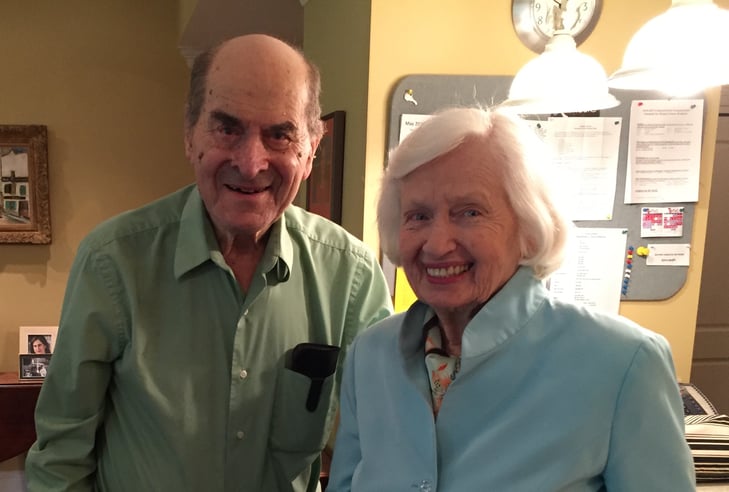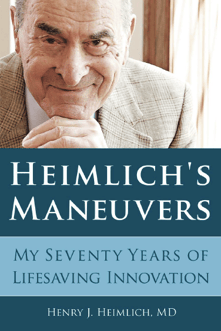
(Dr. Henry Heimlich with Patty Ris)
It’s been a busy week here at Deupree House. As you have probably read or heard about by now, one of our retirement community’s residents, 96-year-old Dr. Henry J. Heimlich  — the physician renowned worldwide for developing an abdominal thrust technique used to save the lives of more than 50,000 choking victims since 1974 — saved the life of a fellow Deupree resident by performing his own namesake maneuver.
— the physician renowned worldwide for developing an abdominal thrust technique used to save the lives of more than 50,000 choking victims since 1974 — saved the life of a fellow Deupree resident by performing his own namesake maneuver.
Naturally, that brought quite a bit of attention to our quiet retirement community here in Cincinnati. We and Dr. Heimlich have been busy answering quite a few inquiries about his heroics.
But we haven’t been so busy that we failed to note the apropos timing of the incident, because today, June 1, is National Heimlich Maneuver Day! It’s an amazing coincidence. And it reminds us that we should talk about the importance of knowing what to do if you encounter a person who is choking.
So, in honor of Dr. Heimlich’s feat, here are three ways you and your family can observe National Heimlich Maneuver Day in 2016.
1. Learn how to perform the Heimlich Maneuver
It might sound simple — and once learned, it is. But when you encounter an adult who you believe may be choking, you and other bystanders should follow a very specific protocol before attempting to perform the Heimlich Maneuver.
First and foremost, if the victim is awake and responsive, try to verify that choking is indeed the problem.
-
Ask, "Are you choking? Can you speak?" DO NOT perform first aid if the person is coughing forcefully and is able to speak. A strong cough can sometimes dislodge the object of its own accord.
-
If the victim cannot speak, and is grabbing at his or her own throat, and/or exhibiting puffed out lips, widened eyes and discolorations (bluish-purple) of the lips:
-
Have another bystander immediately call 911.
-
Step behind the choking person. Clasp your hands together in a bear hug position, just below the person’s sternum (the hard point one can feel in the center of the abdomen, where the rib cages meet).
-
Quickly, forcefully pull up and back into the victim’s chest. This should push residual air from the person’s lungs up into the windpipe, hopefully to expel the lodged object there.
-
Repeat this until the object is dislodged.
-
If you are not having success and the person has become unresponsive, lay the person on his or her back, flat on the floor.
-
Open the mouth and look to see if there is food or an object visible in the throat. If one is visible, try to dislodge it with your hooked index or middle finger.
-
If you can dislodge a visible object and the person does not resume breathing on his or her own, check for a pulse and begin rescue breathing until the person resumes breathing or help arrives. If no pulse is evident, begin full CPR.
-
If you cannot dislodge it, no object is readily visible, or the person’s chest does not rise and fall with rescue breathing, the object is likely lodged far down in the airway. Try thrusting with both hands clasped, up and under the person’s rib cage, from a kneeling position above his or her waist.
There are different methods to learn for performing the Heimlich Maneuver on children, and it’s specifically not indicated for infants 1 year and younger, so perhaps the best thing you can do this National Heimlich Maneuver Day is to...
2. Sign up for a lifesaving first aid class and get certified
Check availability with your local chapter of the American Red Cross for upcoming first aid and basic lifesaving classes. You never know when, like Dr. Heimlich, you might be called into action to save someone’s life.
3.Chew your food slowly and carefully
The easiest way to avoid choking? Remember to chew your food slowly and take small bites, just like your mother taught you.
Chewing food slowly and thoroughly not only makes mealtime safer, but it also might help you to feel more full with less food, making slow chewing a sound weight control technique.
We want you to be safe!
And we know we can speak for Dr. Heimlich as wishing you the same. This National Heimlich Maneuver Day, take a moment to learn how to save a life and how to prevent yourself from becoming a choking victim.













